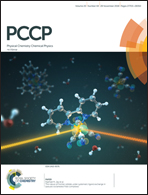Effect of Cu intercalation on humidity sensing properties of Bi2Se3 topological insulator single crystals†
Abstract
Here we report the self-flux method-based synthesis of CuxBi2Se3 (x = 0, 0.13 and 0.25) topological insulator (TI) single crystals with high phase purity for humidity sensing for the first time. The samples were thoroughly characterized using XRD, FESEM, Raman, etc. The chemi-resistive humidity sensing performance of the obtained Cu0.25Bi2Se3 single crystal exhibits high sensitivity (∼849%) with decent response time (24 s) and recovery (25 s) time, negligible hysteresis (<1%) and excellent stability within an 8–97% relative humidity (RH) range at room temperature. The Freundlich isotherm model shows improved adsorption parameters (k and α) for CuxBi2Se3 (x = 0.25) over the entire RH region demonstrating the improved sensing performance of Bi2Se3 TIs with Cu intercalation. The effect of Cu intercalation in Bi2Se3 was investigated using the Langmuir adsorption isotherm (LA) model signifying the role of faster conduction of water vapour over the surface with a single active site for the adsorption–desorption process. The current experimental results suggest that CuxBi2Se3 TIs hold immense potential for important applications related to sensing.



 Please wait while we load your content...
Please wait while we load your content...